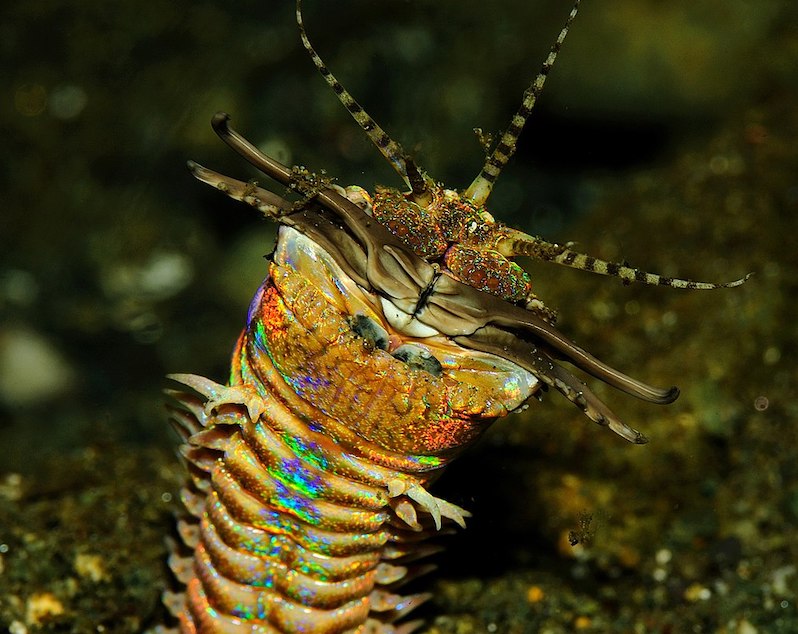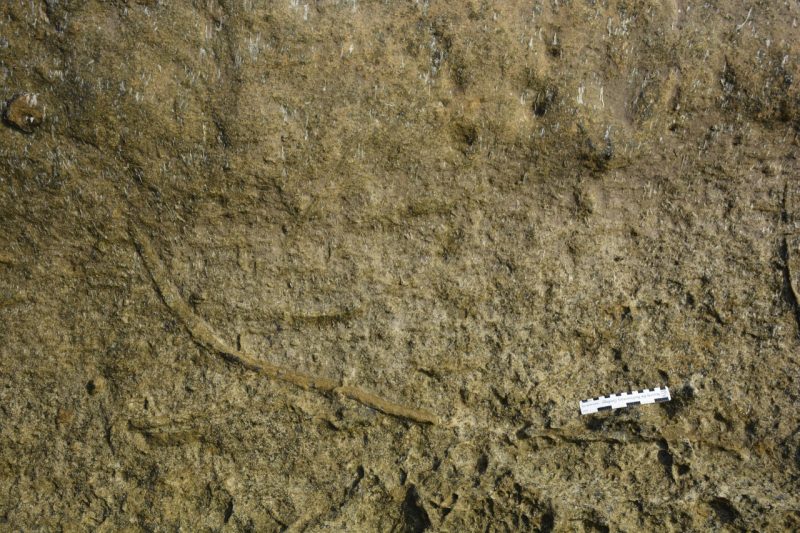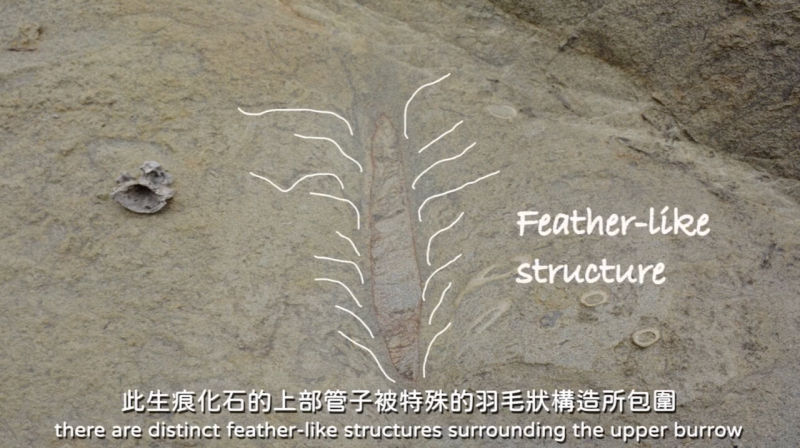
Researchers have found evidence of large predatory worms — some as long as 6.5 feet (2 meters) — that roamed the ocean floor near Taiwan over 20 million years ago. The finding is the result of reconstructing an unusual trace fossil that they identified as a burrow of these ancient worms.
Geologists discovered the peculiar giant L-shaped trace fossil – a geological feature, like track marks and burrows – in a 20-million-year old layer of rock on the northeast coast of Taiwan. In a three-year investigation, an international research team reconstructed the unusual fossil and reached the conclusion that the trace fossil was the burrow of an extinct predatory worm that would surface from the ocean floor to grab prey and drag it into its lair.
Yu-Yen Pan of Simon Fraser University is lead author of the study, published January 21, 2021, in the peer-reviewed journal Scientific Reports. She said in a statement:
I was fascinated by this monster burrow at first glance. Compared to other trace fossils which are usually only a few tens of centimeters long, this one was huge – 2 meters long and 2-3 centimeters in diameter. The distinctive, featherlike structures around the upper burrow were also unique and no previously studied trace fossil has shown similar features.
EarthSky 2021 lunar calendars still available! Order now. Going fast!
The researchers say the ancient worm was similar to the modern-day Bobbit worm, which is also large and predatory, and is sometimes called the “sand striker,” sensing prey with its antennae, then grabbing them with its powerful jaws, and retreating into its burrow. The study authors wrote:
We hypothesize that about 20 million years ago, at the southeastern border of the Eurasian continent, ancient Bobbit worms colonized the seafloor waiting in ambush for a passing meal … When prey came close to a worm, it exploded out from its burrow, grabbing and dragging the prey down into the sediment. Beneath the seafloor, the desperate prey floundered to escape, leading to further disturbance of the sediment around the burrow opening

Modern-day Bobbit worm (Eunice aphroditois), thought to be similar to the worms that made the monster burrow off the Taiwanese coast millions of years ago. The largest known modern Bobbit worm on record reached 9.81 feet in length (2.99 meters) in length, but these worms are very slim, only about 1 inch (2.5 cm) wide. Image via Wikipedia.
Further analysis revealed a high concentration of iron around the upper burrow, leading researchers to believe the worm secreted mucus to reinforce and rebuild its burrow wall after each feeding.
Marine predatory worms have existed for more than 400 million years, since the early Paleozoic era, but their soft tissue bodies decay leaving little trace of their existence behind. This trace fossil is believed to be the first known produced by a sub-surface ambush predator, allowing researchers a rare opportunity to learn more about this ancient sand striker’s behavior.

The lower horizontal section of the ancient worm’s fossilized burrow, found in 20-million-year-old rocks. Image via Yu-Yen Pan.

One key to understanding this discovery was the featherlike structure noticed at the top of the burrow-like structure. It’s thought that, millions of years ago, an ancient sand worm grabbed its prey (possibly a small fish) and dragged it down into its burrow. The fish’s struggle to escape created the featherlike structure. Image is a video still from the video at top.
Bottom line: On the northeast coast of Taiwan, geologists discovered a peculiar giant L-shaped burrow in a 20-million-year old layer of rock. An international research team concluded that the burrow was the home of a giant, predatory sand worm.
Source: The 20-million-year old lair of an ambush-predatory worm preserved in northeast Taiwan
from EarthSky https://ift.tt/2YjJfEA

Researchers have found evidence of large predatory worms — some as long as 6.5 feet (2 meters) — that roamed the ocean floor near Taiwan over 20 million years ago. The finding is the result of reconstructing an unusual trace fossil that they identified as a burrow of these ancient worms.
Geologists discovered the peculiar giant L-shaped trace fossil – a geological feature, like track marks and burrows – in a 20-million-year old layer of rock on the northeast coast of Taiwan. In a three-year investigation, an international research team reconstructed the unusual fossil and reached the conclusion that the trace fossil was the burrow of an extinct predatory worm that would surface from the ocean floor to grab prey and drag it into its lair.
Yu-Yen Pan of Simon Fraser University is lead author of the study, published January 21, 2021, in the peer-reviewed journal Scientific Reports. She said in a statement:
I was fascinated by this monster burrow at first glance. Compared to other trace fossils which are usually only a few tens of centimeters long, this one was huge – 2 meters long and 2-3 centimeters in diameter. The distinctive, featherlike structures around the upper burrow were also unique and no previously studied trace fossil has shown similar features.
EarthSky 2021 lunar calendars still available! Order now. Going fast!
The researchers say the ancient worm was similar to the modern-day Bobbit worm, which is also large and predatory, and is sometimes called the “sand striker,” sensing prey with its antennae, then grabbing them with its powerful jaws, and retreating into its burrow. The study authors wrote:
We hypothesize that about 20 million years ago, at the southeastern border of the Eurasian continent, ancient Bobbit worms colonized the seafloor waiting in ambush for a passing meal … When prey came close to a worm, it exploded out from its burrow, grabbing and dragging the prey down into the sediment. Beneath the seafloor, the desperate prey floundered to escape, leading to further disturbance of the sediment around the burrow opening

Modern-day Bobbit worm (Eunice aphroditois), thought to be similar to the worms that made the monster burrow off the Taiwanese coast millions of years ago. The largest known modern Bobbit worm on record reached 9.81 feet in length (2.99 meters) in length, but these worms are very slim, only about 1 inch (2.5 cm) wide. Image via Wikipedia.
Further analysis revealed a high concentration of iron around the upper burrow, leading researchers to believe the worm secreted mucus to reinforce and rebuild its burrow wall after each feeding.
Marine predatory worms have existed for more than 400 million years, since the early Paleozoic era, but their soft tissue bodies decay leaving little trace of their existence behind. This trace fossil is believed to be the first known produced by a sub-surface ambush predator, allowing researchers a rare opportunity to learn more about this ancient sand striker’s behavior.

The lower horizontal section of the ancient worm’s fossilized burrow, found in 20-million-year-old rocks. Image via Yu-Yen Pan.

One key to understanding this discovery was the featherlike structure noticed at the top of the burrow-like structure. It’s thought that, millions of years ago, an ancient sand worm grabbed its prey (possibly a small fish) and dragged it down into its burrow. The fish’s struggle to escape created the featherlike structure. Image is a video still from the video at top.
Bottom line: On the northeast coast of Taiwan, geologists discovered a peculiar giant L-shaped burrow in a 20-million-year old layer of rock. An international research team concluded that the burrow was the home of a giant, predatory sand worm.
Source: The 20-million-year old lair of an ambush-predatory worm preserved in northeast Taiwan
from EarthSky https://ift.tt/2YjJfEA

Aucun commentaire:
Enregistrer un commentaire